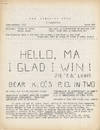
Animal Navigation (Scientific American Library, Number 26).
by Waterman, Talbot H
- Used
- Hardcover
- first
- Condition
- BINDING/CONDITION: pale blue cloth; owner's name stamp in three places (top and bottom edges of the text block and the front end
- ISBN 10
- 0716750244
- ISBN 13
- 9780716750246
- Seller
-
Oroville, California, United States
Payment Methods Accepted
About This Item
New York:: Scientific American Library, 1989.. 1st Printing.. Hardbound . BINDING/CONDITION: pale blue cloth; owner's name stamp in three places (top and bottom edges of the text block and the front endpaper), otherwise a Near Fine book, with a Near Fine dust jacket.. 9.5 inches tall by 8.75 wide . Index. Beige endpapers. Description: Well illustrated, with much in color. ''Biologist Talbot Waterman explains the techniques by which animals as different as the caribou and the Chinese wool-handed crab make their way from one habitat to another -- with none of the instruments or records considered essential to human navigation. After a look at the feats of some 'world-class' animal commuters, the author shows us that all successful navigators must be able to sense direction, distance, and time. We will see that an animal's compass, map, and clock are embedded in a variety of physiological and behavioral mechanics. Like human explorers, some animals pilot by sight: there are birds and bees that navigate by celestial clues and whales that follow the contours of coastlines. Most animals, however employ senses far different from ours, including the bloodhound's nose and the porpoise's 'radar', or echolocation. Dr Waterman explains how visual signals and gravity-sensing systems orient animals and keep them on a steady course. He then documents the various compass-like elements of animal physiology, including the chemoreception that plays a part in salmon homing and moth mating, the sensitivity of some birds to low-frequency infrasounds such as those caused by wind and surf, and the many examples in the animal kingdom of electric and magnetic direction-finding.'' This is the twenty-sixth volume in the Scientific American Library series.
Reviews
(Log in or Create an Account first!)
Details
- Bookseller
- The Bookworm
(US)
- Bookseller's Inventory #
- 065688
- Title
- Animal Navigation (Scientific American Library, Number 26).
- Author
- Waterman, Talbot H
- Format/Binding
- Hardbound
- Book Condition
- Used - BINDING/CONDITION: pale blue cloth; owner's name stamp in three places (top and bottom edges of the text block and the front end
- Edition
- 1st Printing.
- Binding
- Hardcover
- ISBN 10
- 0716750244
- ISBN 13
- 9780716750246
- Publisher
- Scientific American Library
- Place of Publication
- New York:
- Date Published
- 1989.
- Pages
- 243 pages.
- Size
- 9.5 inches tall by 8.75 wide
Terms of Sale
The Bookworm
Books over two pounds being sent by Priority Mail will be shipped at cost. International shipments are at cost. We use flat rate envelopes when possible. Return for refund if not satisfied.
About the Seller
The Bookworm
Biblio member since 2003
Oroville, California
About The Bookworm
We are a small town bookstore, in the same location for over fifteen years. We strive to maintain a wide selection of books in lower price ranges.
Glossary
Some terminology that may be used in this description includes:
- Edges
- The collective of the top, fore and bottom edges of the text block of the book, being that part of the edges of the pages of a...
- Jacket
- Sometimes used as another term for dust jacket, a protective and often decorative wrapper, usually made of paper which wraps...
- Text Block
- Most simply the inside pages of a book. More precisely, the block of paper formed by the cut and stacked pages of a book....
- Fine
- A book in fine condition exhibits no flaws. A fine condition book closely approaches As New condition, but may lack the...

